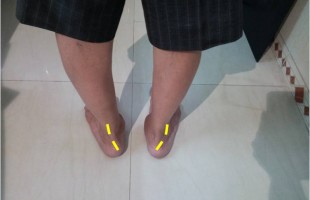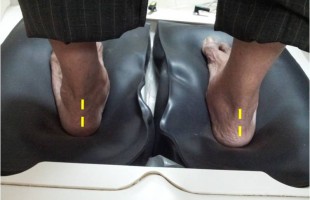Cavus Foot / High-Arched Foot / Supination
Condition, Causes and Symptoms
Pes cavus (high instep, high arch, cavoid foot, and supinated foot type) is a condition in which the foot has a very high arch and in which the sole of the foot is distinctly hollow when bearing weight. A high arch is the opposite of a flat foot, and somewhat less common.
Because of this high arch, an excessive amount of weight is placed on the ball and heel of the foot when walking or standing. Cavus foot can lead to a variety of signs and symptoms, such as pain and instability. It can develop at any age, and can occur in one or both feet. It may be hereditary or acquired, and the underlying cause may be neurological, orthopedic or neuromuscular.
As with certain cases of flat feet, high arches may be painful due to metatarsal compression; however, high arches— particularly if they are flexible or properly cared-for—may be an asymptomatic condition.
The arch of a cavus foot will appear high even when standing. In addition, one or more of the following symptoms may be present:
- Hammertoes (bent toes) or claw toes (toes clenched like a fist)
- Painful Calluses on the ball, side, or heel of the foot
- Pain when standing or walking
- An unstable foot due to the heel tilting inward, which can lead to ankle sprains
- metatarsalgia,
- pain under the first metatarsal,
- plantar fasciitis,
- ankle arthritis and
- Achilles tendonitis.
- Shortened foot length
There are many other symptoms believed to be related to the cavus foot. These include shoe-fitting problems, lateral ankle instability, lower limb stress fractures, knee pain, iliotibial band friction syndrome, back pain and tripping.
Foot pain in people with pes cavus may result from abnormal plantar pressure loading because, structurally, the cavoid foot is regarded as being rigid, non-shock absorbent and having reduced ground contact area.
Treatment
Suggested conservative management of patients with painful pes cavus typically involve strategies to reduce and redistribute plantar pressure loading with the use of foot orthoses and specialised cushioned footwear. Other non-surgical rehabilitation approaches include stretching and strengthening of tight and weak muscles, debridement of plantar callosities, manipulation of the foot and ankle and strategies to improve balance.
Non-Surgical Treatment
Non-surgical treatment of cavus foot may include one or more of the following options:
- Orthotic devices: Custom orthotic devices that fit into the shoe can be beneficial because they provide stability and cushioning to the foot.



